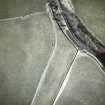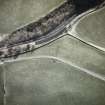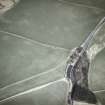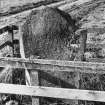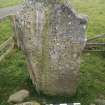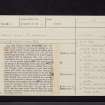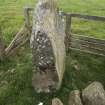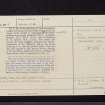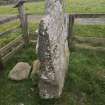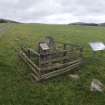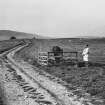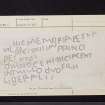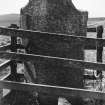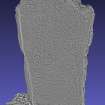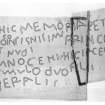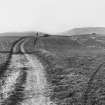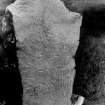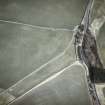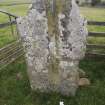Scheduled Maintenance
Please be advised that this website will undergo scheduled maintenance on the following dates: •
Tuesday 3rd December 11:00-15:00
During these times, some services may be temporarily unavailable. We apologise for any inconvenience this may cause.
Whitefield, 'yarrow Stone'
Gravestone (Early Medieval), Inscribed Stone (Early Medieval)
Site Name Whitefield, 'yarrow Stone'
Classification Gravestone (Early Medieval), Inscribed Stone (Early Medieval)
Canmore ID 53078
Site Number NT32NW 5
NGR NT 34795 27442
Datum OSGB36 - NGR
Permalink http://canmore.org.uk/site/53078
- Council Scottish Borders, The
- Parish Yarrow
- Former Region Borders
- Former District Ettrick And Lauderdale
- Former County Selkirkshire
Yarrow Stone, Selkirkshire, inscribed stone
Measurements: H 1.53m above ground level, W 0.80m, D 0.36m
Stone type: whinstone
Place of discovery: NT 3480 2744
Present location: set upright within wooden railings close to where it was found in a field near Yarrow Church.
Evidence for discovery: found during ploughing at the beginning of the 19th century and before 1805, with human bones beneath it. The stone was taken to Bowhill and later returned to where it had been found, where it was set upright sometime in the first half of the 19th century.
Present condition: some flaking and edge damage from the chains used to move it.
Description
One broad face of the stone bears a pecked six-line inscription set vertically in such a way that it reads from top to bottom of the stone. In Latin, it reads: ‘This is the everlasting memorial. In this place lie the most famous princes Nudus and Dumnogenus. In this tomb lie the two sons of Liberalis’.
Date: early sixth century.
References: ECMS pt 3, 432; RCAHMS 1967, no 174.
Compiled by A Ritchie 2016
NT32NW 5 34807 27440
(Nt 3481 2744) STANDING STONE (NR)
OS 6" map (1900)
See also NT32NE 1.
The Yarrow Stone, Whitefield. This well-known early Christian monument stands 50 yds NW of the Selkirk-Moffat highway at a point about 1000 yds W of Yarrow Church (RCAHMS 1957, No. 10), and close to the track that leads to Whitefield. It is an irregular, shouldered slab of whinstone, 5 ft. 1/2 in. in height as now set, 2 ft. 7 1/2 in. in greatest width and 1 ft. 2 in. in general thickness (J A Smith 1863).
It was turned up by the plough at the beginning of the 19th century (C G Cash 1913) and when this ground, then a moor known as Annan Street, was first brought under cultivation; it was then lying prone just under the surface and the remains of human bones were found underneath it. At this time there were about twenty "large cairns" on the moor (NSA 1845). After having been removed to Bowhill for examination, it was returned to Annan Street and was erected at the place of its original discovery (J A Smith 1859).
With this stone must be associated two uninscribed stones in the vicinity - the Glebe Stone (No. 175), 530 yds to the ENE, and the stone at the Warrior's Rest (No. 176), 800 yds to the NE, which marks the site of an Early Christian cemetery. The E face of the stone bears a Latin inscription, roughly executed and in parts badly wasted, which has caused much trouble to epigraphists. (C G Cash 1913; R A S Macalister 1936; Scot Gaelic Stud, vol.2, 221; Corpus Inscriptionum Insularum Celticarum, vol.1, No.515)
The Commissioners are greatly indebted to Mr C A Ralegh Radford, MA, FBA, FSA, and to Professor K H Jackson, MA, Litt.D, who visited and studied the stone and have produced the reports, respectively on the inscription and on the names occurring in it. They are also most grateful to Mr Radford for the drawing of the inscription, made from his own rubbings and observations, which is reproduced as Fig.132. (RCAHMS 1957).
The Yarrow Stone was set up to mark the grave of two British Christian chieftains. It dates from the early 6th century and falls into place in the Early Christian series more richly represented in Wales and Cornwall. The position chosen for the burial was not a churchyard but a small cemetery, probably the family or tribal graveyard alongside a trackway.
RCAHMS 1957, visited 1934 and 1952.
Very good condition, about 3ft high. Fenced.
Information from R Santen, 13 March 1953.
The stone is as described by RCAHMS: little of the inscription on the east face can be made out. The stone is surrounded by a wooden fence.
Visited by OS (EGC) 1 June 1962.
Yarrow Stone
(inscribed) [NAT]
OS (GIS) MasterMap, May 2010.
Publication Account (1985)
The moor known as Annan Street was first brought into cultivation in 1803-4, and the stone was turned up by the plough; it was lying flat just under the surface with human bones below. At that time there were also some twenty "large cairns" on the moor.
Just over 1.5m high as now set, it bears an important six line Latin inscription, fairly roughly carved and in parts badly weathered. The letters are mainly Roman capitals, irregular and sprawling; the words are badly set out and carelessly written! Certain letters, however, provide parallels with stones elsewhere, notably in Wales and Cornwall, and help date it to the early 6th century. A brief translation would run:
''This (is) the everlasting memorial.
In (this) place (lie) the most famous princes
Nudus and Dumnogenus,
In this tomb lie the two sons of Liberalis".
The stone was erected, therefore, to mark the grave of two Christian British chieftains; but burial was not in a churchyard as such, rather in a small cemetery, probably the family or tribal graveyard, alongside a trackway.
The record of bones beneath the stone and of cairns on the moor cannot be dissociated with other discoveries, made in 1857, some 730 m north-east at the Warriors' Rest (NT 354277). There, about 9m south of a standing stone, eight stone-lined cists or graves were found lying east-west Such groups of aligned graves without gravegoods are characteristic of Christian, not pagan burials, and have also been found at the Cat Stane close to Edinburgh Airport (presently inaccessible).
The inscription on the late 5th-6th century Cat Stane suggests that "In this tomb lies Vetta, daughter of Victricius"-presumably a woman of considerable political and social importance amongst the Votadinim, British tribe whose roots and language were closely related to those who emerged subsequently as the Welsh. Much preoccupied with warring, good living and genealogy, their Christianity may have been little more than a veneer-but Christian they were nonetheless, and from the discoveries of their graves, they were fairly liberally scattered across the attractive Lothian plain.
Information from 'Exploring Scotland's Heritage: Lothian and Borders', (1985).
Geophysical Survey (22 September 2014 - 7 November 2014)
A geophysical survey was conducted in the field around the Yarrow Stone and the adjacent field to the east in September 2014 by Archaeological Services Durham University. The works comprised geomagnetic survey of approximately 7ha. No features of probable archaeological significance were identified, however, it is possible that some of the anomalies could reflect the remains of ditches or pits. No features have been identified close to the Yarrow Stone, other than drainage ditches for the existing track. The stone may not have been re-erected exactly where it was originally discovered. A probable igneous dyke, and more subtle geological variation, has also been detected.
Information from OASIS ID: archaeol3-194457 (D Hale) 2014
Magnetometry (August 2015)
A geophysical survey was conducted around the Glebe Stone and to the west of Warrior’s Rest, Yarrow, near Selkirk, in the Scottish Borders in August, 2015. The works comprised geomagnetic survey of approximately 8.5ha. The works were commissioned by Dr David Petts of Durham University on behalf of Mr Jack McCrory and conducted by Archaeological Services Durham University. Although few features of probable archaeological significance have been detected there are a number of possible ditches and pits. For example, part of a possible rectilinear enclosure ditch has been identified south-east of the Glebe Stone, though the surveys have detected no evidence for any features closer to the stone. Occasional small circular anomalies have been detected across the site (for example in Areas 3 and 9), which could possibly reflect the remains of ring-ditches; these could possibly be associated with former cairns. It is likely that any cairns have been destroyed by the removal of stone, almost certainly to the field walls, and that little or no geophysical trace of them survives in the subsoil. Former ploughing of these fields will also have impacted upon any nearsurface features. Features relating to modern and recent agricultural practices have been identified, including former ploughing, land drains, former dykes and animal feeders. Probable geological and geomorphological variation has been detected across the survey area.
Sbc Note (15 April 2016)
Visibility: Standing structure or monument.
Information from Scottish Borders Council
Note (2 September 2020)
Date Fieldwork Started: 02/09/2020
Compiled by: ELF
Location Notes: The stone is as described in previous Canmore records. It was photographed and 3D modelled by the Edinburgh, Lothians and Fife Team for the Scotland's Rock Art Project. The Canmore record also gives an alternative name for the Yarrow Stone as the Warrior's Rest. The Warrior's Rest is a separate stone (Canmore 53054) in the same area.
































